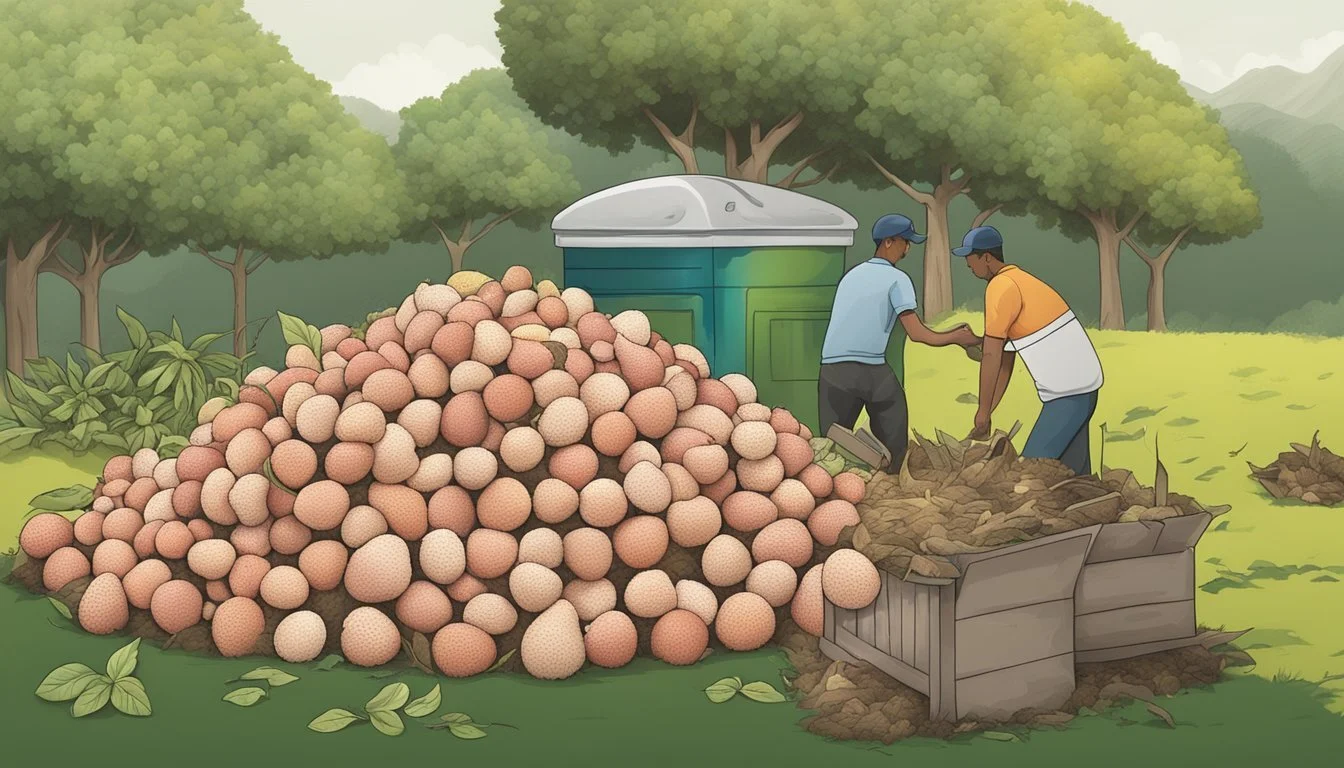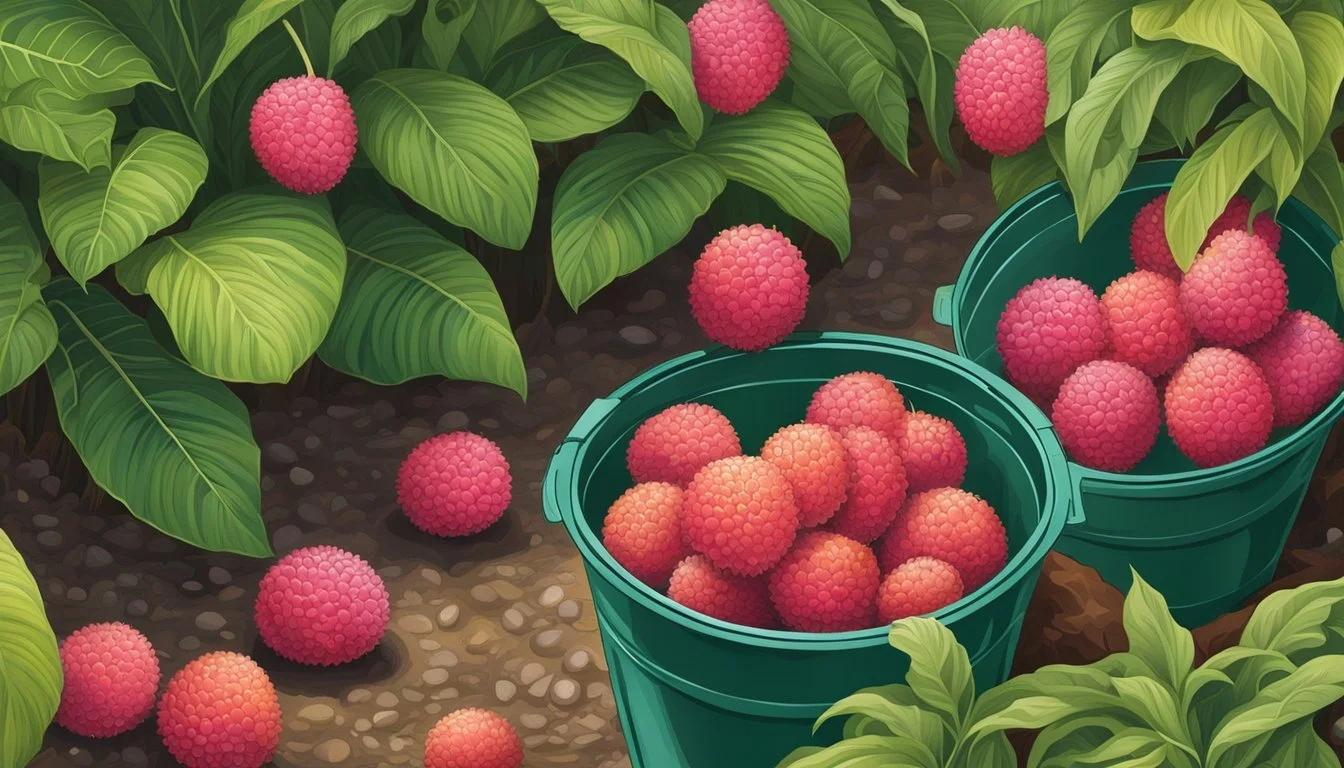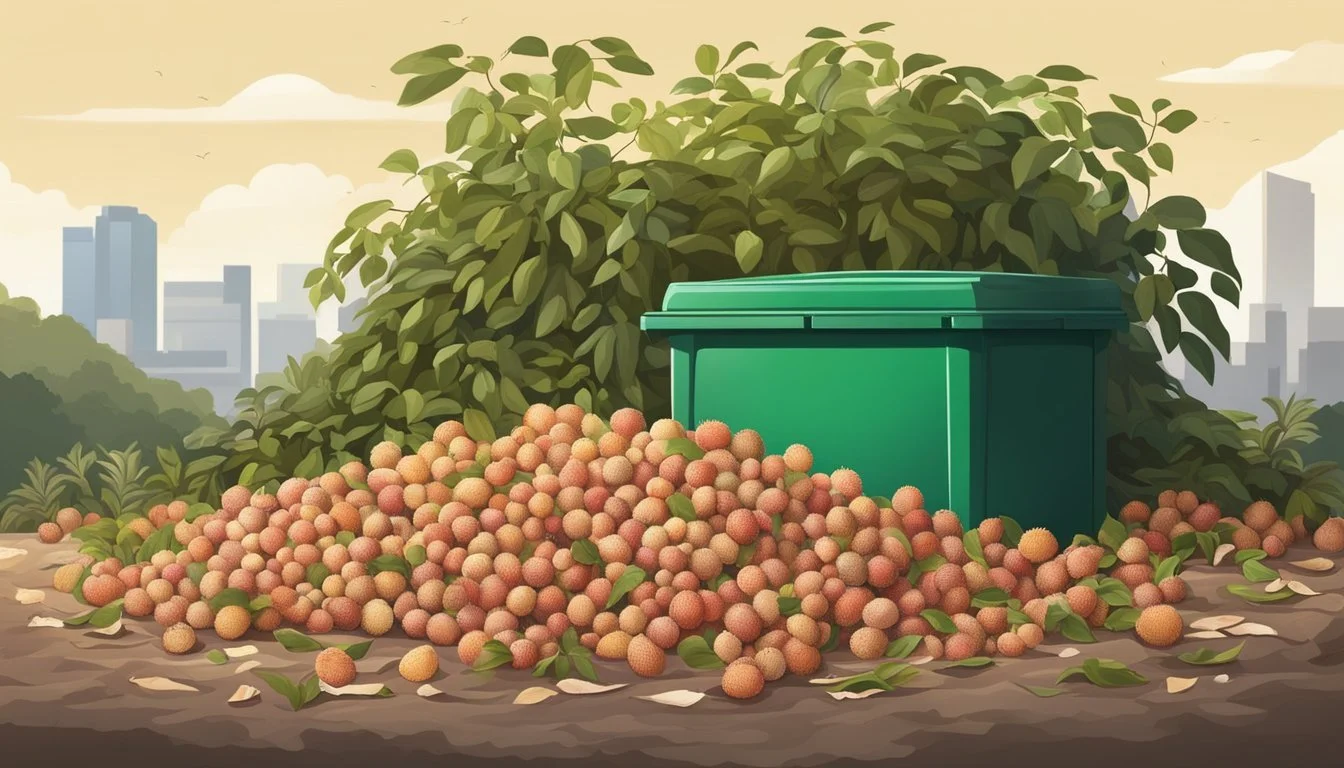Can You Compost Lychee Skins?
A Guide to Fruit Waste Recycling
Composting is a sustainable method to dispose of organic kitchen scraps, turning them into valuable fertilizer for the garden. As part of this process, many fruit scraps are commonly added to compost bins, contributing to the nutrient-rich final product. Lychee, a tropical fruit recognized by its bumpy, leathery skin, is enjoyed for its sweet, perfumed flesh. Once the flesh is consumed, the question arises of whether the remaining rind can be integrated into compost heaps along with other organic matter.
The rind of the lychee fruit, while inedible to humans, is organic and can be considered for composting. Since it is a natural byproduct of consuming the fruit, including it in the compost pile could be an eco-friendly way to handle waste. However, care should be taken as certain fruit rinds may introduce unwanted pests or diseases into the compost, and they might have different decomposition rates compared to other materials.
When adding lychee rinds to compost, one should consider the overall balance of the pile. Ensuring a mix of green and brown materials is crucial for the health and efficiency of the decomposition process. As lychee skins would contribute to the 'green' or nitrogen-rich component, it is important to balance it with 'brown' materials like dried leaves or twigs, which add carbon. This balanced approach supports the creation of high-quality compost that can beneficially augment garden soil.
Understanding Composting Basics
Before diving into the specifics of composting lychee skins, one must grasp the fundamental concepts of composting—a practice that transforms organic waste into valuable fertilizer for the garden.
What is Compost?
Compost is the product of controlled decomposition of organic matter, including food scraps, leaves, and yard waste. It’s a rich, earthy substance that results from the natural breakdown processes of microorganisms, such as bacteria and fungi, along with larger decomposers like worms. Compost is brimming with nutrients, and it's a key ingredient to enrich soil.
Key components in compost:
"Greens" - Rich in nitrogen, these include materials like vegetable scraps, fruit waste, and grass clippings.
"Browns" - These provide carbon and include items such as dried leaves, twigs, and shredded newspaper.
Benefits of Composting for the Garden
Composting offers several benefits for the garden. It improves soil structure, allowing it to better retain nutrients, water, and air. Compost also introduces beneficial microorganisms that help plants grow strong and healthy. By adding compost, gardeners can reduce the need for chemical fertilizers, making gardens more sustainable and eco-friendly.
Improves soil health: Compost adds essential nutrients back into the soil.
Waste reduction: Up to 30% of household waste can be diverted from landfills through composting.
Composting Materials: Dos and Don'ts
When composting, it’s crucial to know what materials are suitable and what to avoid to ensure a successful composting process.
Do compost:
Fruit and vegetable scraps (including lychee skins)
Yard trimmings
Non-glossy paper
Eggshells
Don't compost:
Dairy products and fats
Meat or fish scraps
Diseased plants
Pet wastes
Note on lychee skins: They are organic and can be added to the compost pile. They should be considered “browns” and balanced with “greens” for optimal decomposition.
The Composting Process
Composting is a biochemical process that transforms organic waste into nutrient-rich soil amendment. The efficiency of composting lychee skins, like other organic material, relies on maintaining optimal conditions throughout the process.
Stages of Composting
Mesophilic Stage: The composting process begins in the mesophilic stage, where mesophilic microorganisms thrive at moderate temperatures between 20-40°C (68-104°F). They start the decomposition by breaking down the soluble, readily available compounds in the organic material, including lychee skins.
Thermophilic Stage: As the bioactivity raises the temperature of the compost pile, it enters the thermophilic stage. Temperatures can soar up to 50-70°C (122-158°F) during this phase, eliminating pathogens and weed seeds. The high temperatures are indicative of thermophilic microorganisms decomposing more complex substances like proteins and fats.
Factors Affecting Composting
Temperature: A balance of warm and cool phases is crucial. Thermophilic temperatures should be maintained long enough to break down materials thoroughly without overcooling, which can slow down the process.
Moisture: The compost pile requires moisture levels of around 50-60% for microorganisms to thrive. Too much moisture can lead to anaerobic conditions, while too little stifles microbial activity.
Aeration: Regular aeration ensures oxygen supply, preventing anaerobic conditions. Methods include turning the pile or introducing perforated pipes.
Carbon: An optimal carbon to nitrogen ratio (C) of about 25-30:1 is essential for the microorganisms' activity. Lychee skins, being high in carbon, contribute to this balance.
Maintaining these factors helps decompose lychee skins efficiently in the composting process.
Lychee and Its Compostability
Lychee skins are a natural byproduct of consuming the sweet fruit and, as organic matter, they can play a beneficial role in composting processes.
Characteristics of Lychee Skins
Lychee skins, or peels, are the protective outer layer of the lychee fruit. They are typically reddish-pink to brown, have a rough texture, and are inedible. These peels are rich in organic matter which is an essential component that contributes to the nutrient value in compost.
Decomposition Rate of Lychee Skins
The decomposition rate of lychee skins can be affected by several factors such as temperature, moisture, and the presence of decomposing agents like bacteria and fungi. Generally, lychee peels are not as fibrous as other fruit peels and will break down at a moderate pace within a compost pile.
Adding Lychee to Your Compost Pile
To add lychee skins to a compost pile, it's recommended to cut or tear them into smaller pieces to accelerate decomposition. They should be mixed with other compost materials like green (nitrogen-rich) and brown (carbon-rich) matter to maintain a balanced compost.
Green materials might include: Vegetable scraps, coffee grounds, or grass clippings.
Brown materials might include: Dry leaves, twigs, or cardboard.
Adding lychee skins to a compost pile enriches the resulting compost with valuable nutrients and organic matter, making it an excellent amendment for garden soil.
Materials to Combine with Lychee Skins
When composting lychee skins, it is essential to balance them with appropriate green and brown materials to ensure efficient decomposition and to create nutrient-rich compost.
Green Materials for Nitrogen Balance
Green materials are rich in nitrogen, which is crucial for the growth and reproduction of the microorganisms that break down organic matter. Lychee skins should be complemented with green materials like:
Coffee grounds: A nitrogen-rich substance that adds acidity and nutrients to the compost pile.
Grass clippings: They decompose quickly and add necessary nitrogen to balance the carbon from the lychee skins.
Brown Materials for Carbon Balance
Brown materials provide the necessary carbon that acts as an energy source for the composting microbes. For optimal composting, one should combine lychee skins with brown materials such as:
Leaves: Fallen leaves are a rich source of carbon and help to create air pockets within the compost for better airflow.
Cardboard: Shredded non-waxed cardboard serves as a carbon-rich brown material; however, it must be used sparingly to prevent matting.
Eggshells: Although not a typical brown material, crushed eggshells add calcium to the compost, improving the pile's mineral balance.
One should ensure the compost pile has a balanced mixture of green and brown materials to accelerate the composting process and produce high-quality compost.
Composting Methods and Techniques
Choosing the right composting methods and techniques is crucial for the successful decomposition of organic waste, such as lychee skins, into a nutrient-rich amendment for the soil.
Traditional Composting Methods
Traditional composting involves layering carbon-rich materials, like dry leaves and sawdust, with nitrogen-rich materials, like the skins of tropical fruits and vegetable scraps, to create a balanced compost pile. This method requires regular turning to provide oxygen that speeds up the decomposition process. One can incorporate manure to add nutrients and beneficial microorganisms, further enhancing the compost quality.
Vermicomposting with Worms
Vermicomposting introduces specific species of worms, usually red wigglers, into the composting process. These worms consume and break down organic matter including vegetables and fruit scraps, producing worm castings, a high-quality compost. The process is efficient and suitable for small-scale indoor composting systems as well as outdoor compost bins.
Bokashi Composting
Bokashi composting is an anaerobic process that ferments organic waste, including citrus peels and tropical fruit skins, in a sealed container. This method can quickly handle a variety of kitchen waste by layering it with a Bokashi bran mixture that contains microorganisms. It is noteworthy for producing a leachate that can be used as a liquid fertilizer, while the solid waste is later buried or added to a traditional compost pile to complete the decomposition.
Troubleshooting Common Compost Problems
Composting lychee skins, like other organic matter, can occasionally present challenges such as unpleasant odors, attraction of pests, or difficulty in maintaining optimal composting conditions. By focusing on the key areas of odor management, pest control, and maintaining suitable conditions, one can effectively troubleshoot common compost problems.
Odor Management
Offensive odors often indicate an imbalance in the compost bin. It could be due to excessive moisture, poor aeration, or insufficient carbon-rich material. Adding lime or calcium carbonate helps neutralize the pH and reduce acidity, curtailing foul smells. Incorporating brown materials such as dry leaves, straw, or sawdust can also help by absorbing excess moisture and providing carbon, balancing the green materials like lychee skins and kitchen scraps.
To reduce odors:
Add lime: Sprinkle a small amount to neutralize acidic conditions.
Aerate: Turn the pile regularly to introduce oxygen and prevent anaerobic decomposition.
Balance: Ensure a proper ratio of brown (carbon-rich) to green (nitrogen-rich) materials.
Pest Control
Keeping pests at bay is crucial for a healthy compost pile, especially in a garden setting where lychee skins and similar food scraps can attract unwanted visitors. The use of a bin with a secure lid can be a simple yet effective measure. For those who prefer open piles, burying food scraps under a layer of carbon-rich material can serve as a deterrent. If chickens are present in the garden, one might consider using a closed composting system or keeping the compost area fenced to prevent them from scattering the pile.
To control pests:
Secure bin lids: Use a compost bin with a tight-fitting lid.
Layering method: Bury food waste under brown materials.
Maintaining Suitable Conditions
For compost to decompose effectively, the conditions within the pile must be conducive to the microorganisms at work. This entails maintaining the right balance of moisture and air and providing adequate nitrogen, which can be sourced from materials such as manure. Chicken manure, in particular, is high in nitrogen and can accelerate the composting process when used in moderation.
To maintain conditions:
Moisture balance: The pile should be damp, like a wrung-out sponge, but not waterlogged.
Airflow: Ensure the pile is turned regularly to incorporate air.
Nitrogen: Add manure or other nitrogen-rich materials to augment the decomposition process.
By addressing these specific concerns, one can foster a thriving environment for composting lychee skins and other organic waste, ensuring a rich end product for garden use.
Using Compost in Your Garden
Compost enriches soil, supporting healthier plant growth in gardens. Properly using compost is crucial for enhancing soil structure which benefits a range of plants from trees to vegetables.
When to Apply Compost
Timing Matters: Gardeners should apply compost during the planting season when preparing garden beds, or during the fall to condition the soil for the next year. For annual vegetables, integrating compost into the soil in the spring gives a nutrient boost right as plants are starting their growth cycle.
Spring: Prior to planting, mix compost with soil.
Fall: Spread compost to protect soil during winter.
Methods of Application
Incorporation Into Soil: Working compost into the top 6 inches of soil ensures nutrients are accessible to plant roots. Use a shovel or garden fork for thorough mixing.
Top-Dressing: Spreading a fine layer of compost around existing plants provides ongoing nourishment without disturbing roots. Gardeners often rake in a thin layer over lawns or around trees.
In Beds: Work compost into the soil at a depth of 6 inches.
Around Plants: Add a 1-2 inch layer around the base of plants, avoiding direct contact with stems.
Compost and Plant Health
Nutrient Supply: Compost introduces essential nutrients that improve plant health. Nitrogen, phosphorus, and potassium, along with micronutrients in compost, support overall vitality and growth.
Soil Structure: Healthy soil structure is vital for plant development. Compost enhances the soil's ability to retain moisture and provides a favorable environment for beneficial microorganisms.
For Trees and Shrubs: Compost can encourage robust root growth.
Vegetable Gardens: Use compost to promote high-quality vegetable yields.
Environmental Impact and Sustainability
Composting lychee skins contributes to waste reduction and soil health, aligning with sustainable environmental practices. This section examines the intricate relationship between composting this organic matter and its broader ecological benefits.
Composting and Waste Reduction
Composting lychee skins is an effective method of organic waste management. Lychees, with their edible flesh and biodegradable skins, are often discarded as waste. By composting the skins, individuals can divert this organic matter from landfills, where it would otherwise decompose anaerobically and release methane, a potent greenhouse gas. Statistics suggest that a significant portion of landfill waste could be composted, reducing emissions and the strain on waste management systems.
Composting and Soil Preservation
Composting turns lychee skins into a nutrient-rich amendment for soil, promoting soil preservation. When added to the soil, compost enhances its quality by returning vital nutrients and carbon. This process supports plant growth, especially for trees and other flora, and builds resilience in local ecosystems. Compost also improves soil structure, increasing its water retention capacity and reducing soil erosion.
Advocating for Composting Practices
Advocating for composting practices is essential in educating communities on sustainable waste management. Composting at home or in community centers can minimize environmental impacts by nurturing a cycle of sustainability. It encourages the use of organic matter as a resource rather than waste, promoting a shift in perception towards environmentally conscious habits.








